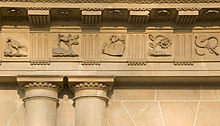Frieze

Doric frieze at the Temple of Hephaestus, Athens (449–415 BCE).

The Circus (Bath), UK. Architectural detail of the frieze showing the alternating triglyphs and metope. (John Wood, the Elder, architect)

Frieze of animals, mythological episodes at the base of Hoysaleswara temple, India

The frieze lining the roof of Yankee Stadium
In architecture the frieze /friːz/ is the wide central section part of an entablature and may be plain in the Ionic or Doric order, or decorated with bas-reliefs. Even when neither columns nor pilasters are expressed, on an astylar wall it lies upon the architrave ('main beam') and is capped by the moldings of the cornice. A frieze can be found on many Greek and Roman buildings, the Parthenon Frieze being the most famous, and perhaps the most elaborate. This style is typical for the Persians.
In interiors, the frieze of a room is the section of wall above the picture rail and under the crown moldings or cornice. By extension, a frieze is a long stretch of painted, sculpted or even calligraphic decoration in such a position, normally above eye-level. Frieze decorations may depict scenes in a sequence of discrete panels. The material of which the frieze is made of may be plasterwork, carved wood or other decorative medium.[1]
In an example of an architectural frieze on the façade of a building, the octagonal Tower of the Winds in the Roman agora at Athens bears relief sculptures of the eight winds on its frieze.
A pulvinated frieze (or pulvino) is convex in section. Such friezes were features of 17th-century Northern Mannerism, especially in subsidiary friezes, and much employed in interior architecture and in furniture.
The concept of a frieze has been generalized in the mathematical construction of frieze patterns.
Contents
1 Achaemenid friezes
2 Greek friezes
3 Indian friezes
4 External links
5 References
Achaemenid friezes

Achaemenid frieze designs at Persepolis.
Greek friezes

Ionic frieze at the Erechtheum, Athens, (421–406 BCE).

Top: Kyanos frieze from Tiryns. Bottom: Frieze of the Erechtheion in Athens, 4th BCE.

Frieze from Delphi incorporating lotuses with multiple calyxes.
Indian friezes

Frieze of the lost capital of the Allahabad pillar, with two lotuses framing a "flame palmette" surrounded by small rosette flowers, 3rd BCE

Rampurva bull capital, detail of the abacus, with two "flame palmettes" framing a lotus surrounded by small rosette flowers, 3rd BCE

Frieze of the Sankissa elephant, 3rd BCE
External links
 Media related to Friezes at Wikimedia Commons
Media related to Friezes at Wikimedia Commons "Frieze". Encyclopædia Britannica (11th ed.). 1911..mw-parser-output cite.citationfont-style:inherit.mw-parser-output qquotes:"""""""'""'".mw-parser-output code.cs1-codecolor:inherit;background:inherit;border:inherit;padding:inherit.mw-parser-output .cs1-lock-free abackground:url("//upload.wikimedia.org/wikipedia/commons/thumb/6/65/Lock-green.svg/9px-Lock-green.svg.png")no-repeat;background-position:right .1em center.mw-parser-output .cs1-lock-limited a,.mw-parser-output .cs1-lock-registration abackground:url("//upload.wikimedia.org/wikipedia/commons/thumb/d/d6/Lock-gray-alt-2.svg/9px-Lock-gray-alt-2.svg.png")no-repeat;background-position:right .1em center.mw-parser-output .cs1-lock-subscription abackground:url("//upload.wikimedia.org/wikipedia/commons/thumb/a/aa/Lock-red-alt-2.svg/9px-Lock-red-alt-2.svg.png")no-repeat;background-position:right .1em center.mw-parser-output .cs1-subscription,.mw-parser-output .cs1-registrationcolor:#555.mw-parser-output .cs1-subscription span,.mw-parser-output .cs1-registration spanborder-bottom:1px dotted;cursor:help.mw-parser-output .cs1-hidden-errordisplay:none;font-size:100%.mw-parser-output .cs1-visible-errorfont-size:100%.mw-parser-output .cs1-subscription,.mw-parser-output .cs1-registration,.mw-parser-output .cs1-formatfont-size:95%.mw-parser-output .cs1-kern-left,.mw-parser-output .cs1-kern-wl-leftpadding-left:0.2em.mw-parser-output .cs1-kern-right,.mw-parser-output .cs1-kern-wl-rightpadding-right:0.2em
"Frieze". Encyclopædia Britannica (11th ed.). 1911..mw-parser-output cite.citationfont-style:inherit.mw-parser-output qquotes:"""""""'""'".mw-parser-output code.cs1-codecolor:inherit;background:inherit;border:inherit;padding:inherit.mw-parser-output .cs1-lock-free abackground:url("//upload.wikimedia.org/wikipedia/commons/thumb/6/65/Lock-green.svg/9px-Lock-green.svg.png")no-repeat;background-position:right .1em center.mw-parser-output .cs1-lock-limited a,.mw-parser-output .cs1-lock-registration abackground:url("//upload.wikimedia.org/wikipedia/commons/thumb/d/d6/Lock-gray-alt-2.svg/9px-Lock-gray-alt-2.svg.png")no-repeat;background-position:right .1em center.mw-parser-output .cs1-lock-subscription abackground:url("//upload.wikimedia.org/wikipedia/commons/thumb/a/aa/Lock-red-alt-2.svg/9px-Lock-red-alt-2.svg.png")no-repeat;background-position:right .1em center.mw-parser-output .cs1-subscription,.mw-parser-output .cs1-registrationcolor:#555.mw-parser-output .cs1-subscription span,.mw-parser-output .cs1-registration spanborder-bottom:1px dotted;cursor:help.mw-parser-output .cs1-hidden-errordisplay:none;font-size:100%.mw-parser-output .cs1-visible-errorfont-size:100%.mw-parser-output .cs1-subscription,.mw-parser-output .cs1-registration,.mw-parser-output .cs1-formatfont-size:95%.mw-parser-output .cs1-kern-left,.mw-parser-output .cs1-kern-wl-leftpadding-left:0.2em.mw-parser-output .cs1-kern-right,.mw-parser-output .cs1-kern-wl-rightpadding-right:0.2em
References
^ "Parthenon Frieze". www.mcah.columbia.edu. Retrieved May 7, 2017.



